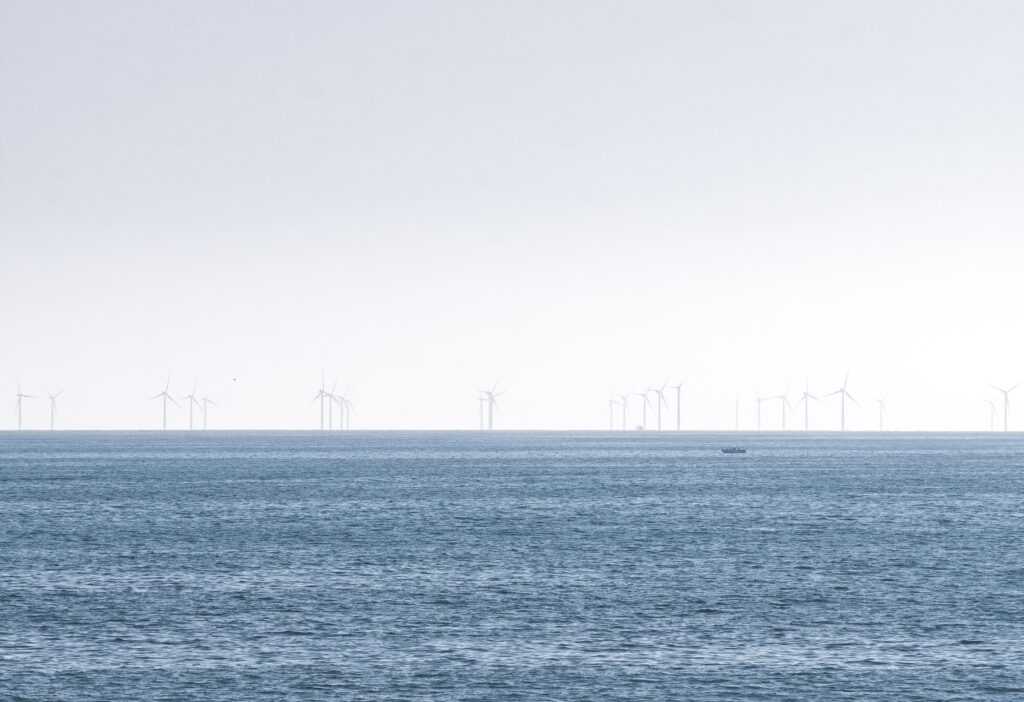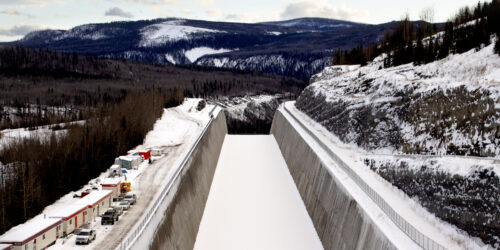Tedium, Tins and Turbines: Sleepwalking in Doggerland

This post by Elliot Honeybun-Arnolda and Reuben Martens originally appeared as part of a series on Environmental Histories of the Future on NiCHE, the Network in Canadian History & Environment.
“[The old man] would talk about homes and settlements—a place that had flooded thousands of years ago. He would talk about woods and hills and rivers, and he would trade away crate-loads of turbine parts for maps that showed the seabed as if it were land.”[1]
Doggerland was once upon a time a vast area of marshlands, wooded valleys, lagoons, and hills that connected the United Kingdom with the Northern coasts of mainland Europe (today’s France, Belgium, Netherlands, Germany, and Denmark). It flooded some 8000 years ago and is now submerged beneath what we know as the North Sea. Ben Smith’s eponymous novel, Doggerland (2019), features this lost land as its setting, and takes place in the not so distant future (or possibly an alternative present) at a large-scale wind farm somewhere in the North Sea. The novel, as we will explore in this short essay, illuminates a unique take on imagining environmental futures.
Often, environmental futures portayed in literature, film, or other forms of visual media fall too easily into categories of apocalyptic environmentalism, techno-utopianism, or strategic realism, and as a result, are left portrayed as inevitable scenarios. However, we argue that Doggerland defies traditional modes and discourses of future-making, moving beyond such traditional distinctions along the axes of techno- and ecocentrism and energopolitics. Doggerland offers a critical environmental future that is firmly rooted in our sociotechnical and material past and warns us of our problematic entanglements of (energy) abundance, infrastructure, and quick techno-fixes for the climate. In doing so, Doggerland depicts a more plausible, yet rarely imagined outcome – one that is not an apocalyptic dystopia nor a harmounious techno-utopia, but rather a drab and tedious “dull-topia,” where life as we would know it in the West, comes to a painfully slow stop.

In Doggerland, we follow two characters, simply known as “the boy” and “the old man”—rarely referred to by their proper names (respectively Jem and Greil)—while they try to keep a wind farm operational in the North Sea, presumably somewhere halfway between the UK and the Netherlands. They live in dire and claustrophobic conditions on the farm’s almost derelict maintenance rig, going out on the sea to repair broken windmills and salvage parts from ones that are non-functional. Their only contact with “the Mainland”—which we know nothing about (or even if the mainland is, in fact, land at all)—is a figure called “the pilot,” who comes by every few months with essential provisions, such as food (tins only), spare repair parts for the turbines, random articles of clothing, and medicine. The main point of intrigue revolves around the boy’s father, who at some point before that start of the narrative attempted to flee from the rig to the mainland, or so it is implied, but disappeared in that act and never returned. The novel never quite resolves what happened to the father, leaves the reader guessing as to why the boy and the old man keep working at the rig, and what is at stake in this environmental future.

Typically, environmental futures that are often imagined today fall into two categories: technocentrism and ecocentrism. Technocentrism, put simply, is the belief and ideals that we will emerge out of the current climate and environmental crisis victorious based on the successful innovation of science and/or technology: think of the diverse forms of geoengineering proposed (aerosol injections, carbon capture and storage), green or sustainable capitalism, and even varying forms of political and economic intervention (like policies and taxes). These beliefs signal, more often than not, only slight adjustments to our business-as-usual attitudes, and do not look to radically alter our relationship with the environment. We can continue our lives (in the West), committed to consumption and pursuit of economic growth if we can find technology or interventions that reduce our impact and change our behaviours. Ecocentrism, on the other hand, aims to radically alter the ways in which we inhabit the earth. To live more simply, more attuned to the needs of nonhuman entities and to focus on methods of degrowth. Ultimately, ecocentrism holds, consumption and growth are incompatible with sustainable futures, and what is needed is more local and low impact living (e.g., through eco-communitarian lifestyles and considering the more-than-human in all types of decision-making).
In Doggerland, we are beyond these options. Absence is a powerful part of its poignancy. Left to imagine our own futures through the question of why the boy and the old man are there, we may envisage that, in the world of the novel, science and technology did not materialise environmentally sustainable futures. Or, we may also envisage that it did, but something impeded its ability to do something worthwhile (like counter our rising emissions and temperatures)—political inaction, lack of global cooperation, or, as we have seen in many countries during the COVID-19 pandemic, a sustained ignorance of scientific advice. Nonetheless, we are left with the absence of society (as we know it) and a weak grip on what is left of society and livelihoods as it comes to a slow stop, without any cataclysmic events.
Readers of the novel may note that Smith evokes Doggerland as a historical site of environmental change through subtle textual clues, such as the integration of very short vignettes that describe the changing geographic and environmental properties of Doggerland over time. Yet, it is also very much an invocation of a climate changed present-future, notably through the use of vernacular Dutch swear words (“klote” and “godverdomme”) and interjections in the English spoken by the protagonists. These small linguistic traits hint at the current real-life projections that since roughly one third of the Netherlands notoriously lies below sea level, the UK has seen an influx of many Dutch refugees due to the flooding of Dutch cities as a result of rising sea levels—not a completely unlikely scenario.[2]
While Doggerland may appear on the surface as a contemporaneous reinterpretation of a Samuel Beckett play, with its monotonously slow and seemingly pointless depiction of life aboard the wind farm’s maintenance rig, it actually holds a much larger truth about a collective, and flawed, imagination of our possible visions of environmental futures. One that, just perhaps, out of all scenarios, deviates from the way future-making usually works, one in which were humans are either triumphant or managing to survive. In Doggerland, they are just simply existing, observing the cyclical nature of the Earth’s rotation and the maintance repairs of the (now) archaic turbines.
While the novel is bleak, it never truly becomes a dystopia. The characters do not seem to be in much despair, or overly nostalgic. The setting, while harsh and despite hints about a heavily polluted sea (all they fish up are plastics), is not overtly one of extreme disaster, and they are not scouring for resources as they have a relatively steady delivery of goods coming in. Yet, it clearly is no utopia either—a strange and remarkable feat for a work of climate fiction.

If anything, it surpasses the idea of imaginable (climate) futures and makes its narrative feel uncomfortably close to our current reality, one of sleepwalking into the future, one of unaddressed slow violence, to use the now famous term from Rob Nixon.[3] The novel misses any sense of urgency about its dire ecological situation and settles for familiar action, The boy and the old man are working for “the Company,” maintaining the wind farm, committed to the existing order of a previous world, but to what end? The electricity producing capacity of the farm is only marginally above 50 percent, and by all expectations will only keep declining, because they do not have sufficient tools or resources to keep up proper maintenance. It is that strange infrastructural paradox of the West, where unless infrastructures fully break down, we do not pay much attention to how well something is maintained—nobody cares, as long as it works, an attitude the Company clearly embodies in the novel.[4]
Further, Doggerland reveals a neoliberal commitment to an energopolitics based on the notion that as long as there is energy, consumers do not ask questions about it, or at what cost it was extracted, or how it has impacted the earth.[5] In all its monotony, Doggerland reveals something fundamentally flawed about our current entanglements and affordances with energy, with the idea of abundance, freedom, and general ignorance about what maintains our lifestyles. The suffering of disenfranchised peoples, trapped in the jaws of neoliberal petrocapitalism—evoked in the novel through the literal confinement of the two protagonists on the maintenance rig they cannot escape—is what sustains the “good life” for the rest of us. An environmentally just and harmonious future is now absent, yet they continue to sustain deteriorating technology as a way of ordering their lives in the present. Moreover, the boy and the old man continue to be confronted with the dilapidating effects of climate change, working day and night to keep energy production going and to stop their home on the rig from falling apart and rusting away, while simultaneously being unable to fish or grow proper food—if this is dystopic, then we also need to start asking questions about the status of our environmental present, as this scenario is by no means one that is far-fetched, or not etched in reality.
Ultimately, Doggerland provides a novel lens into the unusually imagined, yet quite plausible environmental future of absence and monotony—where the only things that remain are commitments to, and objects of, our sociotechnical pasts, memory aides of way back when, and the environmental history that they represent. Doggerland, both as novel and physical space, becomes a hauntological site of our climate changed reality, projected into a near future, where the flawed ideologies of neoliberal petroculture are just perpetuated without question or resistance.
The novel feels uncomfortable simply because it is a confrontation with an environmental future to be, one that we are slowly dragging ourselves into because we lack a sense of urgency in our climate responses. The wind farm will not save us, and it will not save the environmental future, if that is all the action we take. Envisioning the future takes more than just wild utopias or desolate dystopias devoid of context. Simple modes of technocentrism or ecocentrism without radical re-consideration of history, politics, and culture will only ever be fantasies of the future, rather than possible futures in and of themselves. The “dull-topia” of Doggerland show us what we do not want from such futures. Perhaps it serves as a wake-up call, that it is time to stop sleepwalking into environmental collapse, and time to achieve the environmental futures that are sustainable for us all. The urgency and changes to secure an environmentally sustainable future need to happen now—“The old man bent down and picked up a pinch of dust. ‘Everything changes, if you wait long enough.’ The boy stood up and brushed the dust off his hands. ‘I don’t want to wait.’”[6]
[1] Ben Smith, Doggerland (London: 4th Estate, 2019), 28-29.
[2] Rutger de Graaf, Nick van de Giesen, and Frans van de Ven, “Alternative Water Management Options to Reduce Vulnerability for Climate Change in The Netherlands,” Natural Hazards 51, no. 3 (2009): 407-422.
[3] Rob Nixon, Slow Violence and the Environmentalism of the Poor (Cambridge, MA: Harvard University Press, 2011).
[4] See e.g. Dominic Boyer, “Revolutionary Infrastructure,” in Infrastructures and Social Complexity: A Companion, ed. Penelope Harvey, Casper Jensen, and Atsuro Morita (London: Routledge, 2013), 174-186; Brian Larkin, “The Politics and Poetics of Infrastructure,” Annual Review of Anthropology 42 (2013): 327-343; Bruce Robbins, “The Smell of Infrastructure: Notes Toward an Archive,” boundary 2 34, no. 1 (Spring 2007): 25-33.
[5] Dominc Boyer, Energopolitics: Wind and Power in the Anthropocene (Durham, NC: Duke University Press, 2019)
[6] Smith, Doggerland, 238.






Your method of describing everything in this piece of writing is truly fastidious, all can simply understand it, Thanks a
lot.